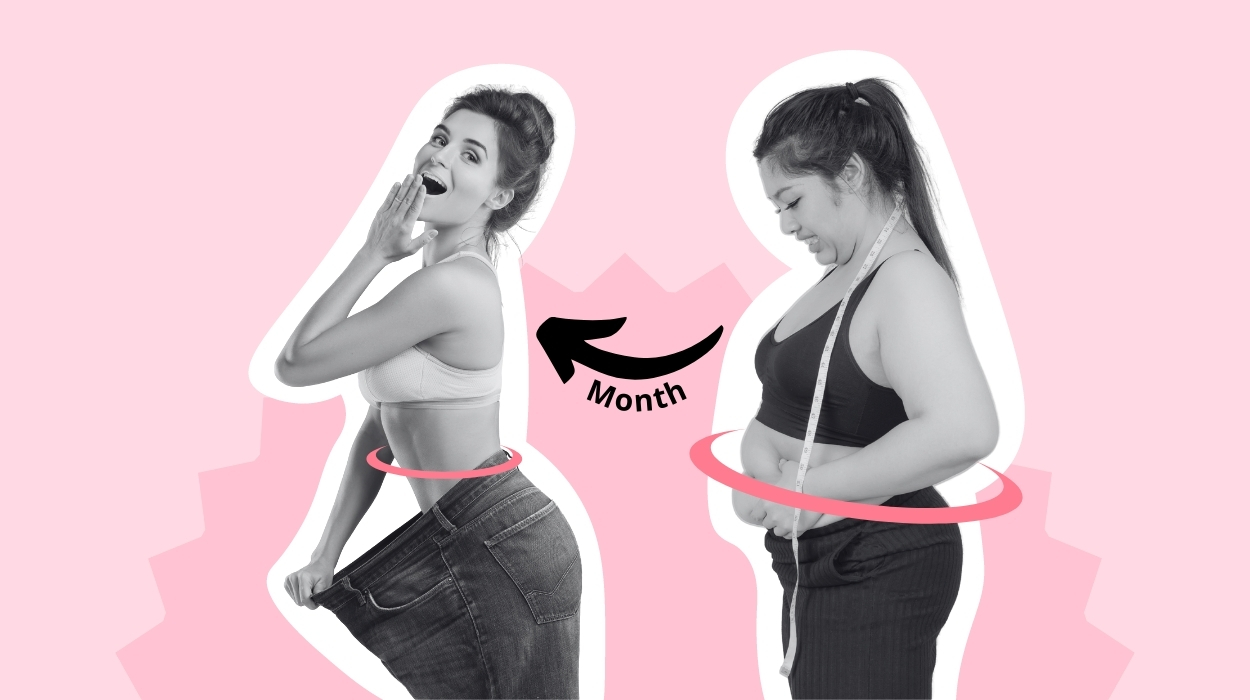Taking the initial steps to a healthier you can be overwhelming. You’ll need to focus on a strategic blend of diet and lifestyle changes to shed excess belly fat in a month. With the right approach and consistent effort, you can see incredible results on your weight loss journey.
This comprehensive guide will dive into the secrets to sculpting a leaner midsection. You’ll learn how to implement sustainable lifestyle changes beyond mere calorie counting. We’ll explore a holistic approach that maximizes results, from intelligent dietary choices to increasing weekly activity.
Learn more about the potential of your body’s natural fat-burning capabilities as we cover tips and tricks for how to lose belly fat in a month. This isn’t just about losing weight. It’s about adopting habits that foster better well-being and a healthier body.
How To Lose Belly Fat In 30 days?
The best way to lose tummy fat in a month is to combine the following:
- Get plenty of restful sleep
- Exercise daily
- Reduce stress
- Incorporate resistance training into your workouts
- Take the right supplements
- Add core exercises to your workout routine including crunches, leg raises, planks, Russian twists, bicycle crunches, and reverse crunches.
- Improve your nutrition on your diet plan.
How To Lose Belly Fat In A Month?
You’ll want to combine healthy nutritional choices with other lifestyle adjustments for the best weight loss results. Here are some lifestyle changes that can amplify the effectiveness of a comprehensive weight loss strategy to help you reach your goals in a month:
Get Plenty Of Restful Sleep

Quality sleep is pivotal to your overall health and affects your body composition. Research indicates that insufficient sleep may correlate with an elevated risk of obesity and visceral fat accumulation in the form of increased belly fat.[1]
Adequate sleep is often an underestimated strategy for reducing body fat, but it’s crucial for optimal fat metabolism and reducing the risk of visceral fat accumulation. Chronic sleep deprivation significantly increases calorie intake[2] by disrupting hunger-regulating hormones[3] and elevating cortisol levels. Sleep-deprived individuals get four hours of sleep or less per night.
Strive for seven to nine hours of sleep[4] each night. Maintain a consistent routine, create a calming bedroom environment, and limit screen time before bed to ensure you get good sleep quality.
Exercise Daily
Staying active is an excellent way to burn fat and reduce weight. Some studies show that physical activity is even more effective than dietary changes[5] in reducing stubborn belly fat, although other studies contradict this.[6]
Studies highlight the effectiveness of high-intensity cardio[7] exercises to help burn fat around the midsection. High-intensity interval training proves equally effective as moderate-intensity continuous exercise regarding fat loss.
Consistent exercise also yields various health benefits beyond reducing belly fat, from lowering your risk[8] of heart disease to enhancing your mood.[9] Aim for 30-60 minutes[6] of regular aerobic exercise daily to target abdominal visceral fat, reducing it by 15%-20% and improving overall health.
Reduce Stress
Effectively managing your stress plays a critical role in reducing body fat. Elevated stress levels can trigger visceral fat storage from excessive insulin and cortisol release.[10] Prolonged exposure to this stress hormone and increased insulin levels can contribute to weight gain and amplify the associated health risks.
Integrate stress-reducing practices into your daily routine if elevated stress is a problem. Meditation, deep breathing exercises, and yoga can lower your cortisol levels.[11] You should also set aside time for hobbies,[12] social connections, and regular physical activity.[13] These act as a protective measure against stress-related effects and promote a healthier overall lifestyle.
Incorporate Resistance Training Into Your Workouts
Resistance training is an excellent way to preserve and build muscle mass. Research suggests that resistance training may help reduce tummy fat, particularly in those with prediabetes,[14] type 2 diabetes, and fatty liver disease. Resistance training workouts involve weight lifting or strength training.
One study on overweight teenagers showed that combining strength training with aerobic exercise resulted in a more substantial loss of visceral fat.[15] Consult your doctor before you lift weights or start a strength training routine. You can also hire a certified personal trainer to create an exercise plan that brings you closer to your goals.
Take The Right Supplements
Several supplements are available to help reduce your overall body fat. Probiotics offer potential health benefits[16] by enhancing your gut health and improving immune function. Research shows that a balanced gut microbiome plays a significant role in weight regulation and can help reduce excess fat.
Notably, probiotics in the Lactobacillus family[17] can help reduce visceral fat. While available research is promising, additional research is needed to further investigate the effects of probiotics on weight loss. Aside from doctor-prescribed and OTC diet pills, various other supplements cater to weight loss needs. Thermogenic supplements[18] contain ingredients like caffeine to increase your metabolism and burn calories. Fat burners typically include components like green tea extract or conjugated linoleic acid, promoting fat breakdown.
Appetite suppressants, like glucomannan,[19] help create a sense of fullness and prevent individuals from consuming excess calories. Additionally, carb blockers can hinder the absorption of carbohydrates.
It’s crucial to approach supplements with caution. Understanding your individual needs and consulting with a healthcare professional can ensure safety and effective use.
Add Core Exercises To Your Workout Routine
Although visible abdominal muscles require a lower body fat percentage, adding core exercises to your routine is helpful. While you won’t get ab muscles by doing hundreds of sit-ups daily, you can develop your core by adding these exercises to your routine.
How to reduce belly fat exercise? As you’re losing weight, focus on adding more and more core exercises to your routine. Sure, sit-ups are helpful, but there is a significant variety of options you can choose. Popular and useful exercises to build lean muscle in your abdomen include:
Crunches
Crunches are a core-strengthening exercise performed by lying on your back, bending your knees, and placing your hands behind your head. This exercise helps improve core strength and stability.
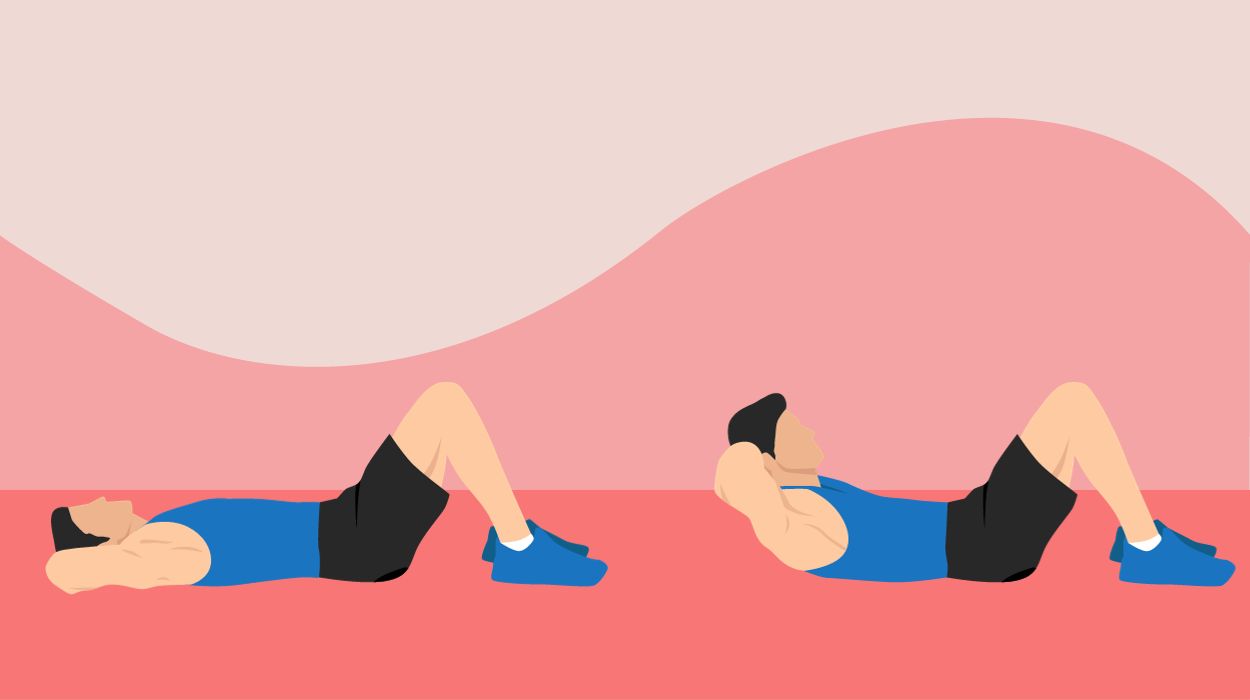
How to do:
- Lie on your back, knees bent, feet flat on the floor.
- Place hands behind your head, elbows wide.
- Lift your upper body, exhaling.
- Inhale, lower back down without straining neck.
Tips:
- Engage core muscles to lift your upper body.
- Keep your neck relaxed, don’t pull with your hands.
- Start with three sets of 15-20 reps, adjusting as needed.
Optimal Sets and Reps: Aim for three to four sets in a workout session.
Leg Raises
Lie on your back and lift your legs toward the ceiling without bending your knees. This exercise helps tone the lower abs and improves core stability.
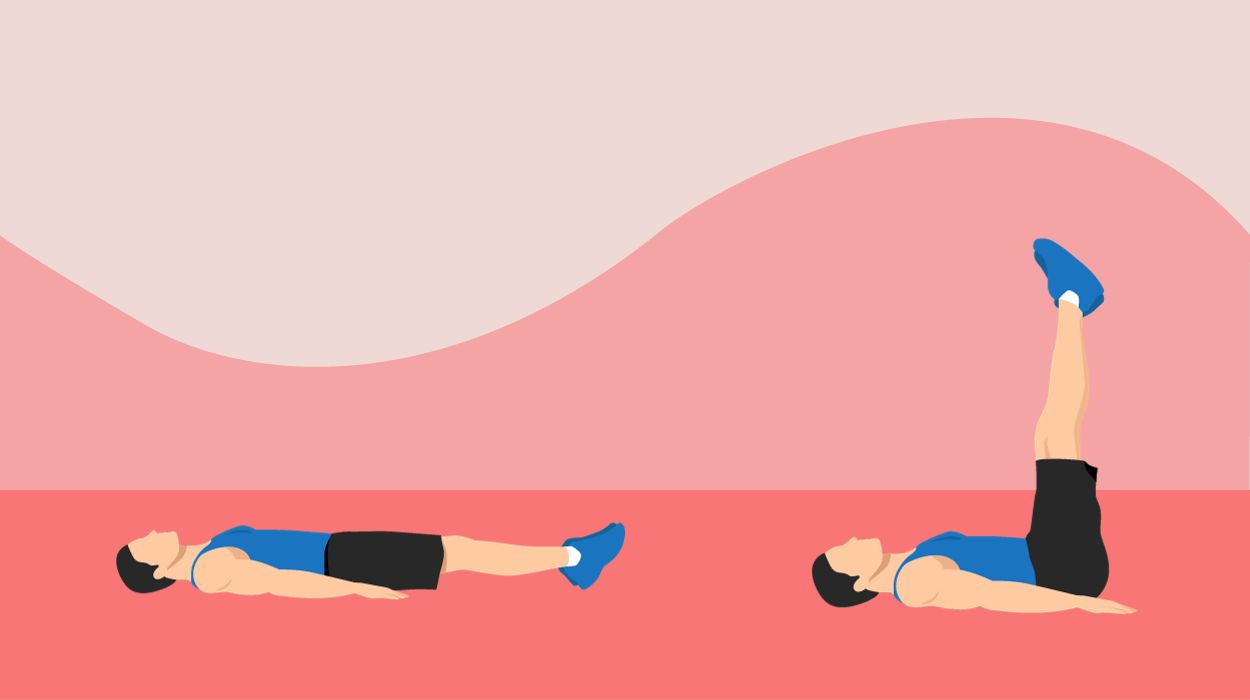
How to do:
- Lie on your back, hands under your hips or beside.
- Lift legs slowly, keeping them straight.
- Lower with control, don’t touch the floor.
- Exhale as you raise your legs, inhale as you lower.
- Perform three sets of 12-15 reps with proper form.
Tips:
- Begin with a range of motion that suits your ability.
- Keep your lower back pressed into the floor to prevent arching.
- Avoid swinging legs; use controlled movements.
Optimal Sets and Reps: Two or three sets of 10-12 reps.
Planks
Planks are a static core-strengthening exercise where you hold a push-up-like position with arms extended, and your body forms a straight line from head to heels. This exercise targets the entire core, improves stability, and builds endurance.
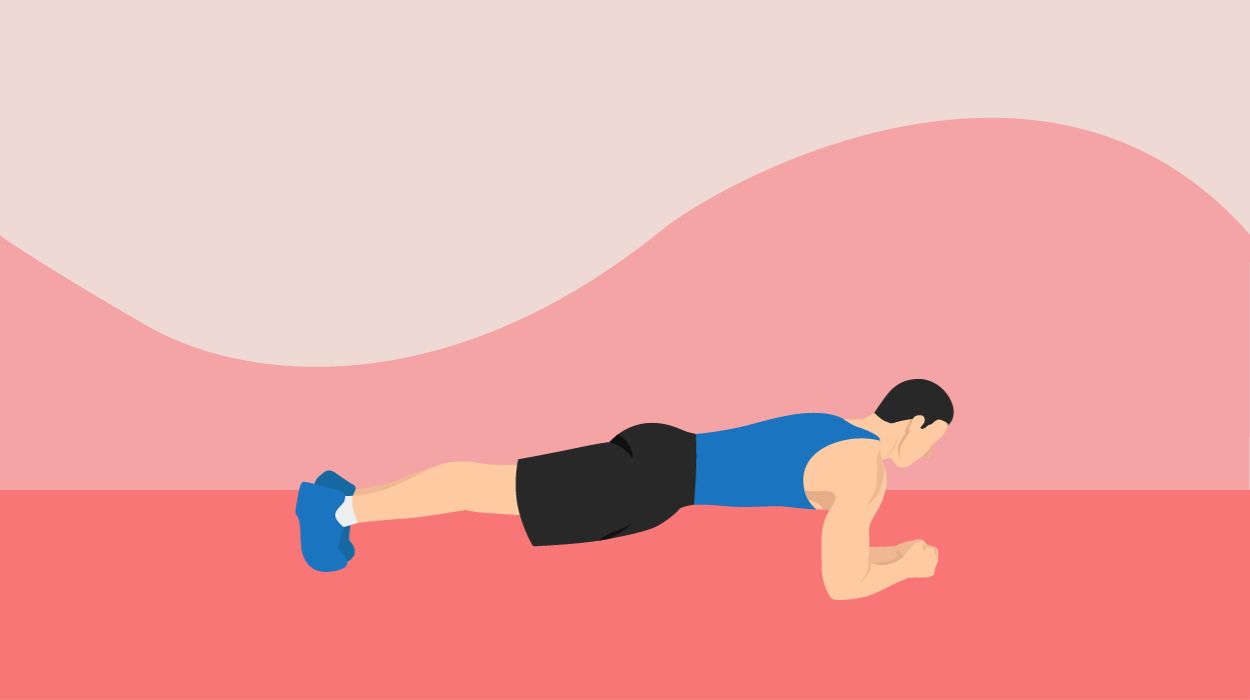
How to do:
- Start in a push-up position, arms straight under the shoulders.
- Engage the core, and hold a straight line from head to heels.
- Breathe deeply, and maintain for 30-60 seconds.
Tips:
- Keep your body in a straight line from head to heels, with elbows under your shoulders.
- Engage your core, glutes, and thighs, and avoid lifting your hips or sagging your lower back.
- Breathe steadily, focusing on maintaining a tight and stable posture.
Optimal Sets and Reps: Perform three to four sets, holding each plank for 20-30 seconds.
Russian Twists
Sit on the floor, lean back slightly, and twist your torso from side to side. This exercise enhances core strength, stability, and rotational agility, making it a popular choice in core and conditioning workouts.
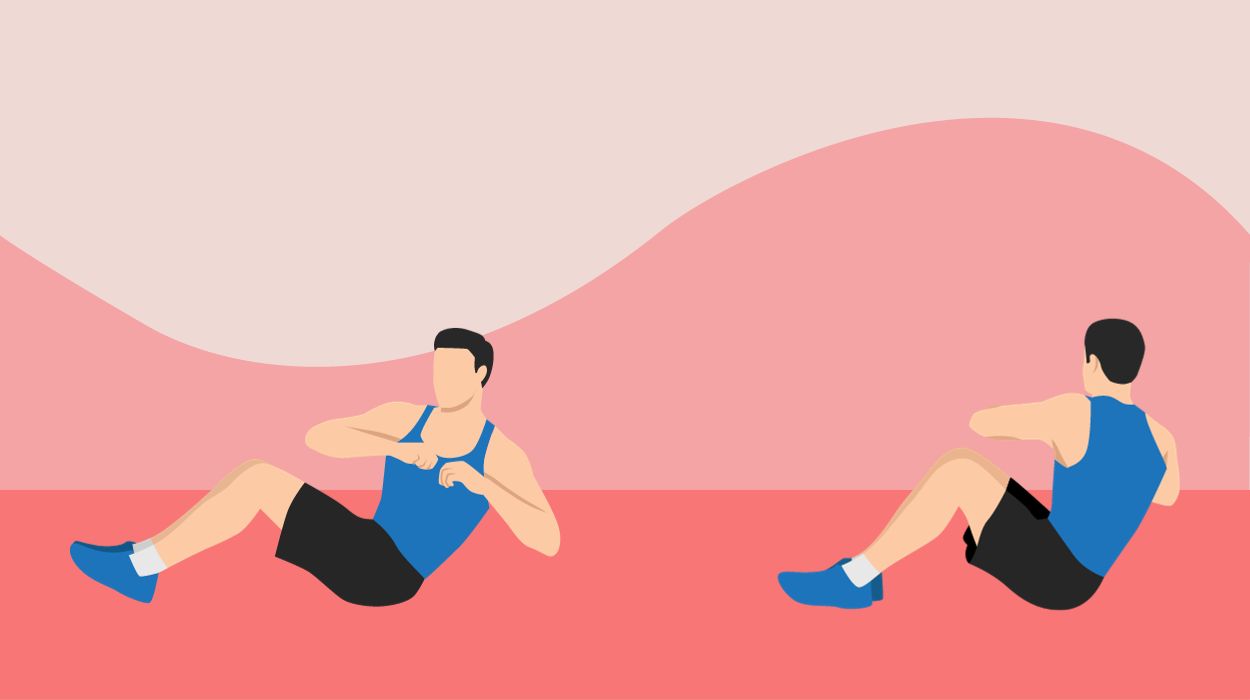
How to do:
- Sit down, knees bent, feet flat, lean back slightly.
- Lift feet off the floor for advanced difficulty.
- Clasp hands or hold weight in front of the chest.
- Rotate the torso, moving hands from side to side.
- Breathe evenly, and engage your core throughout the movement.
Tips:
- Keep your back straight and your abs engaged to protect your spine.
- Twist from your core, not just your arms, to maximize oblique engagement.
- For beginners, keep their feet on the ground; raise them for more challenge.
Optimal Sets and Reps: Perform three sets of 12-15 repetitions on each side.
Bicycle Crunches
Lie on your back with your hands behind your head. Bring one knee towards the opposite elbow and then alternate.
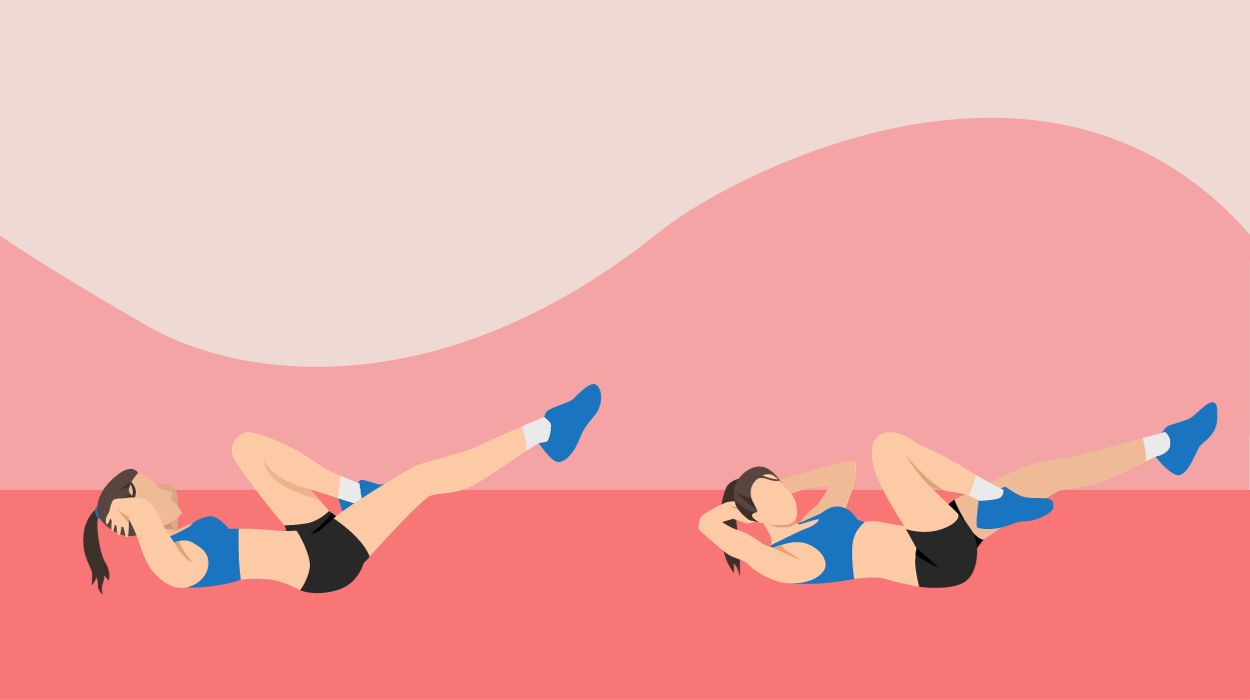
How to do:
- Lie flat, hands behind head, knees bent, feet off the ground.
- Lift shoulders off the floor, engaging core muscles.
- Bring right elbow to left knee, extending right leg out.
- Switch sides: left elbow to right knee, extend left leg.
- Continue alternating in a fluid, cycling motion.
Tips:
- Keep your lower back pressed into the floor to prevent strain.
- Elongate and alternate your legs smoothly as if pedaling a bicycle.
- Touch your elbows to the opposite knees to fully engage the obliques.
Optimal Sets and Reps: Perform three sets of 15-20 repetitions on each side.
Mountain Climbers
Mountain Climbers is a dynamic, full-body exercise that mimics running in a plank position. This high-intensity move combines cardiovascular and strength training, targeting the core, arms, and legs. It’s excellent for building agility, endurance, and metabolic rate, making it a staple in many fitness routines.
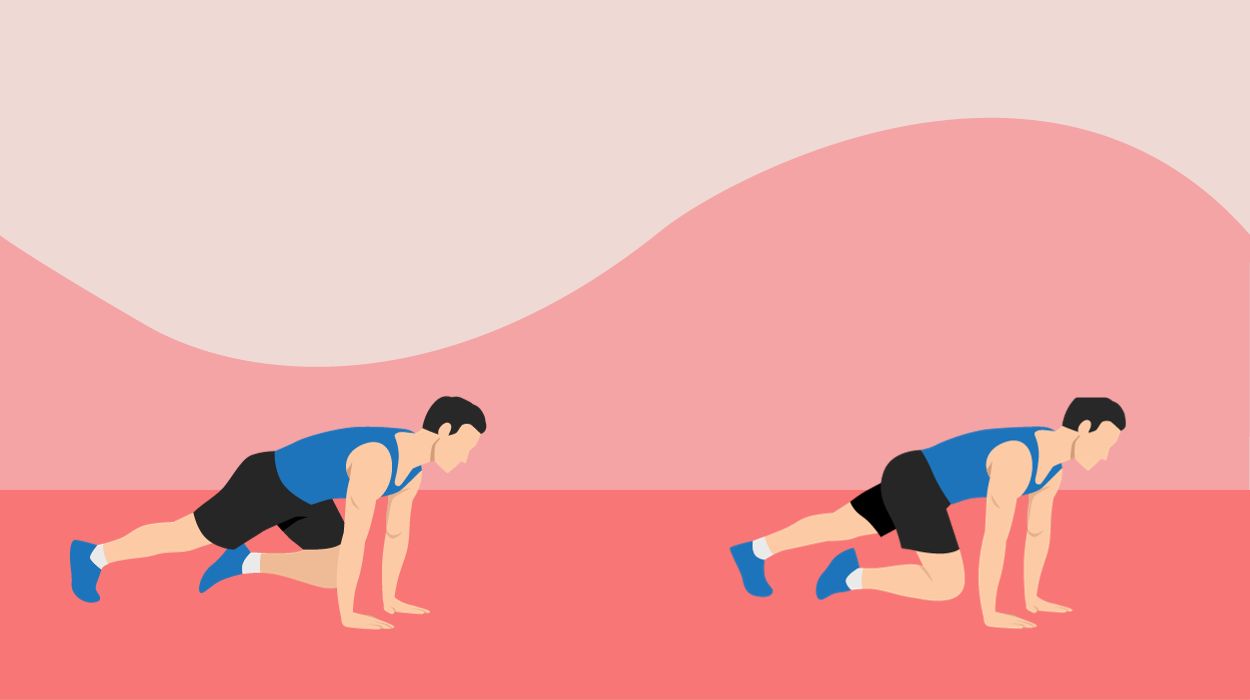
How to do:
- Start in a high plank position, hands under shoulders.
- Engage the core, keeping the back flat and body straight.
- Bring the right knee towards the chest, then return to the plank.
- Quickly switch, bringing the left knee towards the chest.
- Alternate legs rapidly, maintaining steady breathing.
Tips:
- Maintain a strong plank position, avoiding hip sagging or piking.
- Keep your shoulders over your wrists and engage your core throughout.
- Focus on smooth, controlled knee drives rather than speed.
Optimal Sets and Reps: Perform three sets of 30-45 seconds each.
Reverse Crunches
Reverse Crunches are an effective core exercise focusing on the lower abdominals. This movement strengthens the core muscles, particularly the lower abs, and helps improve overall core stability and posture.
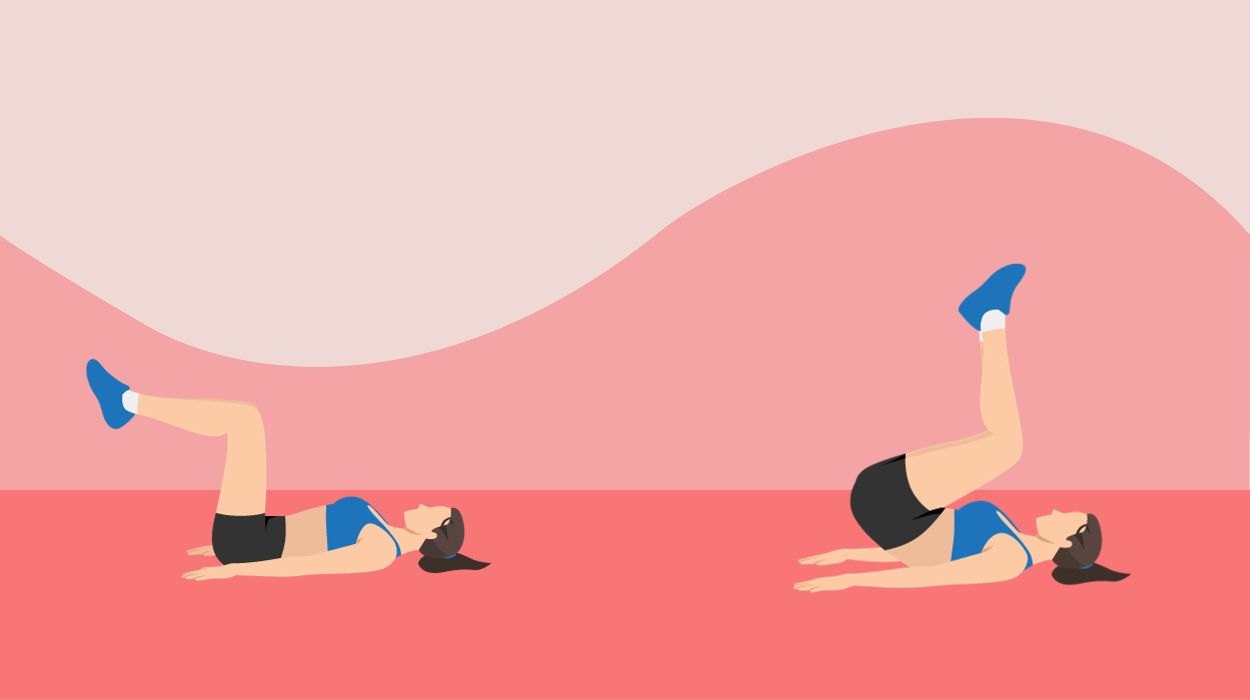
How to do:
- Lie flat on your back, arms by your sides.
- Bend knees, keeping feet flat on the ground.
- Lift knees towards the chest, curling hips off the floor.
- Control the movement; slowly lower back to start position.
- Keep movements steady, engaging the core throughout.
Tips:
- Engage your lower abs to lift your hips, not momentum.
- Keep your movements controlled and avoid swinging your legs.
- Exhale as you crunch in, and inhale when returning to the starting position.
Optimal Sets and Reps: Perform three sets of 10-15 repetitions.
Side Planks
Support your body on one elbow and the outer side of your foot. Hold your body in a straight line.
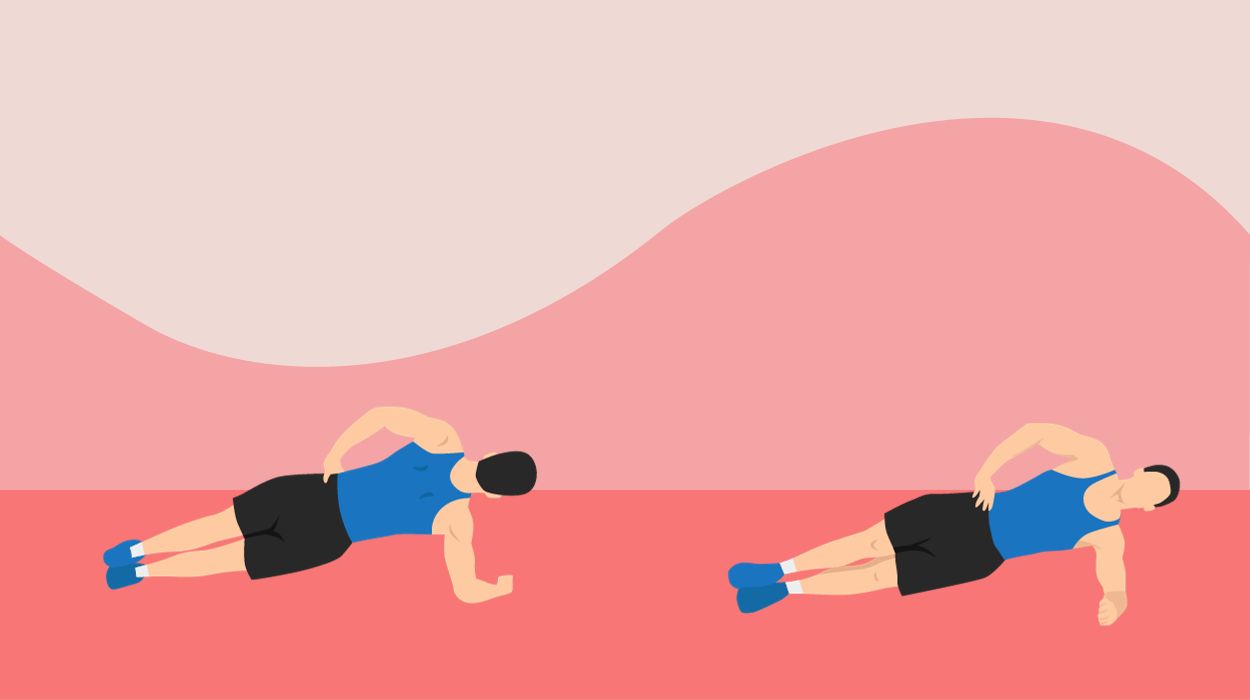
How to do:
- Lie on your side, legs extended and feet stacked.
- Prop up on your forearm, elbow under your shoulder.
- Lift hips, forming a straight line from feet to head.
- Keep core engaged and body straight.
- Hold the position, then switch to the other side.
Tips:
- Ensure your supporting elbow is directly under your shoulder to avoid strain.
- Keep your body in a straight line from head to heels for proper alignment.
- Engage your core and glutes to maintain stability throughout the exercise.
Optimal Sets and Reps: Perform two or three sets, holding each side plank for 20-30 seconds.
Flutter Kicks
Flutter Kicks are a simple yet effective lower abdominal exercise performed while lying on your back. This exercise strengthens the core, especially targeting the lower abs and hip flexors.
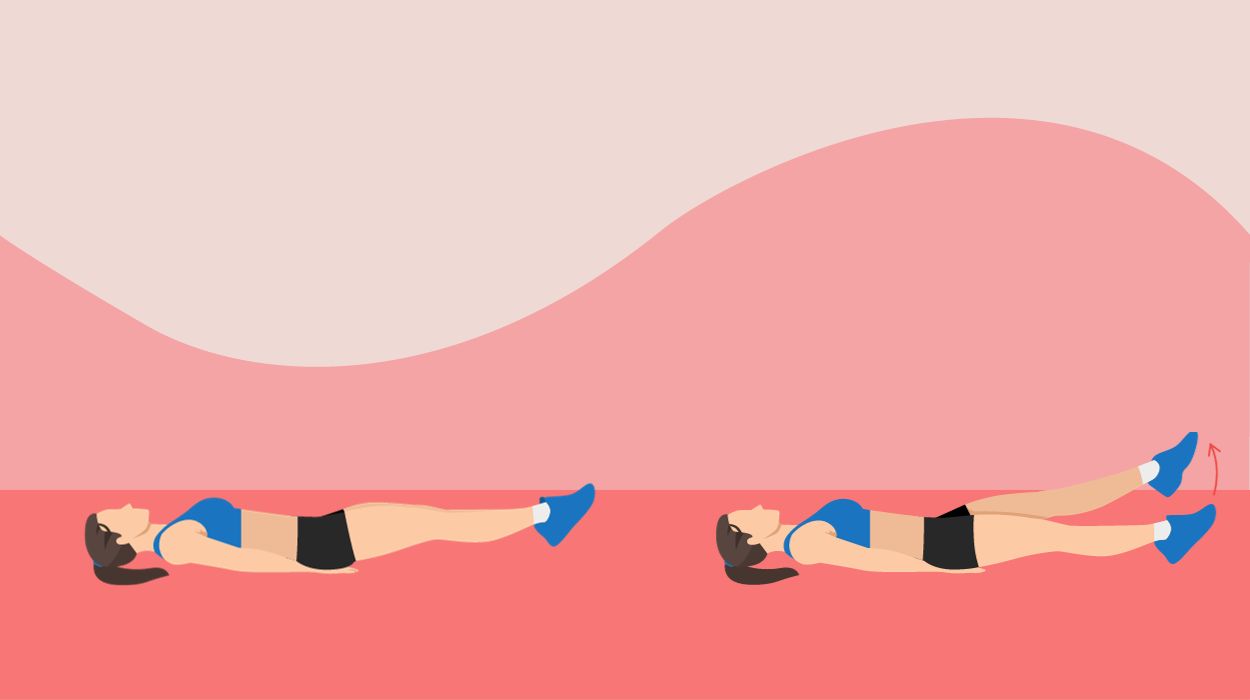
How to do:
- Lie on your back with arms at your sides.
- Press lower back into the floor, engaging the core.
- Lift legs slightly off the ground, keeping them straight.
- Alternately lift each leg in a small, fluttering motion.
- Maintain controlled, steady movements without touching the floor.
Tips:
- Lie flat with your lower back pressed firmly against the floor to prevent strain.
- Keep your legs straight and lifted slightly, engaging your core throughout the movement.
- Perform small, controlled kicks, avoiding too much movement in the hips or legs.
Optimal Sets and Reps: Perform three sets of 20-30 kicks (each leg counts as one kick).
Remember, it’s crucial to maintain proper form and consistency for effective results. Consult a certified personal trainer for additional ideas or a tailored fitness plan.
Losing Belly Fat In A Month With A Nutritious Diet

Good nutrition is the foundation of any weight loss plan. You’ll want to embrace a diet that doesn’t just restrict calorie intake but one that fuels your body for effective weight loss. Finding the proper diet for your body lays the groundwork for sustainable results.
Follow these steps to improve your nutrition on your one-month diet plan to reduce belly fat.
Eat A High-Protein Diet
Following a high-protein diet can improve your weight loss results. Protein plays a crucial role in weight management. It stimulates the release of the satiety protein peptide YY, reducing your appetite and promoting a sense of fullness.
Protein also boosts your metabolism and preserves muscle mass during weight loss. Many studies highlight a correlation between higher protein intake and reduced abdominal fat.[20]
Additionally, protein has a higher thermic effect.[21] Since it is harder to break down, your body needs to spend more energy. This ultimately leads to more calories burned. As defined by some studies, a high-protein diet is generally 27%-35%[22] of your daily calories, with a good protein range between 1.2-1.5 g/kg.[23]
Higher ranges are reserved for those with malnutrition, illness, or increased activity. For example, elite athletes trying to lose weight should aim for 2.0 g/kg daily.[24] Contact your doctor if you have chronic kidney disease or liver disease, as protein recommendations are different than those of a healthy individual.
Cut Back On Carbs
Reducing carbs can be an excellent way to lose fat, especially around the midsection. The debate remains on the effectiveness and health consequences of strict low-carb diets. However, reducing refined carbohydrate intake can help with weight loss, as high intake is a risk factor for insulin resistance.[25]
Practicing intermittent fasting and using the Mediterranean diet during your eating window will lower your overall carbohydrate intake. On this diet, you will also avoid things like fruit juice, which is a refined carb. You will opt instead for lower-carb choices like berries.
Try substituting refined carbs with unprocessed, starchy alternatives to improve metabolic health, reduce the risk of[26] heart disease, and reduce belly fat. It can also promote steady energy and minimize fat storage, as reduced refined carb intake helps regulate blood sugar levels.
Emphasize whole, nutrient-dense foods like fresh fruits and vegetables, lean proteins, and unrefined grains to create a balanced eating pattern supporting weight loss goals. Lowering your carbohydrate intake also encourages your body to tap into stored fat for energy. Cutting back can reduce your risk of insulin resistance and other related health issues.
Limit Sugar-Sweetened Beverages
Sugar-sweetened beverages typically contribute to weight gain because they increase your daily caloric intake with empty calories. Beverages with added sugars, like fructose, can contribute to abdominal fat. Unlike solid calories, liquid calories are not processed by the brain in the same way, which leads to excess calorie[27] intake and fat storage.
A study on individuals with type 2 diabetes revealed that consuming one or more servings of sugary drinks per week was directly linked to increased belly fat.[28] Avoid sodas, fruit juices, sweet tea, and alcoholic beverages with added sugars to target belly fat.
Track Your Food Intake
The fundamental principle of any weight loss plan is to consume fewer calories than your body requires for maintenance. Keeping a food diary can help you monitor your calorie intake, a proven strategy for effective weight management.[29]
There are several online trackers and apps available today. Beyond calorie tracking, these tools offer insights into nutritional components[30] like protein, carbs, fiber, and micronutrients. They also provide a comprehensive look at your diet and daily physical activity.
Tracking your food intake is an excellent way to make more informed decisions about your nutrition. Find the right food tracking option for you, and you’ll create a sustainable approach to weight loss and improved health.
Reduce Alcohol Intake
While moderate alcohol consumption is acceptable, excessive intake can contribute to several harmful effects.[31] Studies indicate a considerable link between heavy alcohol consumption and an increased risk of excess abdominal fat storage.
Consider cutting back if you drink alcohol regularly and more than one or two drinks at a time. An older study showed that those who drank daily and limited their intake to less than one drink per day had less belly fat[32] than those who consumed more on less frequent occasions.
Limiting alcohol intake is also recommended with most diet plans since most alcoholic drinks have a high-calorie density.[31]
Additionally, alcohol hinders the liver’s fat metabolism, leading to an increase in visceral fat. Therefore, managing your alcohol intake is crucial for maintaining a healthy weight.
Drink Green Tea
Regularly consuming green tea offers several health benefits, particularly in reducing body fat. It contains the antioxidant epigallocatechin gallate,[33] which is believed to enhance metabolism. Studies suggest that EGCG can reduce inflammation and aid in belly fat reduction.
Research indicates that consuming green tea in doses below 500 milligrams per day[34] for 12 weeks can boost weight loss. Regular intake can also positively impact body fat and waist circumference. Studies are promising, but more high-quality research is essential to support further the association between green tea and reduced body weight.
Stay Hydrated
Drinking enough water is crucial for losing fat. Studies suggest that pre-meal water consumption reduces food intake[35] without compromising satiety. This decreases the calories you consume by approximately 9% while increasing your sense of fullness.
Substituting soda, fruit juices, and other high-calorie drinks with water can help amplify your weight loss results. Aim for at least eight large glasses of water daily. This doesn’t just hydrate your body and eliminate toxins, but it also supports fat loss around your midsection.
Start the day with a glass of warm water to boost your metabolism. Maintain hydration throughout the day,[36] and find creative ways to get your daily water intake. Consider incorporating lemon into warm water to reduce intestinal inflammation[37] and stomach bloating.
Is It Possible To Reduce Belly Fat In A Month?
Yes, it is possible to reduce abdominal fat in a month with a comprehensive approach. You’ll want to emphasize nutrient-dense whole foods with plenty of fiber and protein while limiting sugary and processed food items. Hydration also plays a critical role in enhancing metabolism and promoting a sense of fullness.
Along with dietary adjustments, incorporating regular physical activity into your day is crucial to your results. Combine aerobic exercises, like brisk walking or jogging, with strength training routines to target visceral and subcutaneous fat.
While substantial progress is possible in a month, setting realistic expectations is essential. Rapid weight loss may not guarantee sustainable results and can create other health risks. Additionally, individual responses vary to weight loss strategies.
Aim to lose four to eight pounds monthly for achievable and healthy progress. This means you’ll focus on losing one to two pounds per week.
Focus on adopting healthier lifestyle habits that extend beyond the month, ensuring a gradual and lasting transformation. Consult a healthcare professional, registered dietitian, or certified personal trainer for more personalized guidance to optimize your results.
Tips To Get The Most Of Your One Month Plan
Here are some additional health and weight loss tips to maintain your results:
- Be strict about nighttime snacks. Mindless eating can easily throw your diet off course. Snacking in front of the TV or after dinner is common in weight loss plateaus. Close the kitchen after a particular hour or find a low-calorie snack to satisfy your hunger.
- Don’t eliminate your favorite foods. You can still enjoy the foods you love without cutting them out altogether. The key is moderation. Instead of cutting out your favorites, limit your intake. Eat a few candies instead of the whole bag, or purchase a bakery item instead of an entire box of cookies.
- Spice up your foods for variety. Many people think that a healthy diet is all about bland foods. However, adding herbs and spices to your foods can help you maintain motivation and satisfaction.
- Keep the processed and packaged foods out of the house. Make sure your pantry and refrigerator are stocked with healthy options. Avoid buying processed foods at all. If the unhealthy snacks aren’t there, you won’t be tempted to eat them.
- Don’t skip breakfast. Not eating breakfast can make you feel incredibly hungry later and increase your risk of turning to unhealthy foods or binge eating at lunch. Additionally, studies also show that consuming breakfast can improve sleep quality[38] in healthy individuals. Eat a healthy, well-balanced breakfast to get your day started.
- Add fiber to your diet. Increasing fiber intake can prevent constipation, promote satiety, and aid good digestion. Good fiber sources include whole grains, nuts, and most fresh fruits and vegetables.
- Weigh yourself often. While reducing the number on the scale is one component of achieving that flat stomach, non-scale victories involve weight loss. Studies show that regularly weighing yourself[39] is an effective way to improve and maintain your results.
- Celebrate your successes. Rewarding yourself when you’re successful in losing weight can encourage more success. Just stay away from food-related rewards. See your favorite movie, buy yourself a gift, or set a prize for each significant milestone.
Conclusion
Losing belly fat in a month is challenging but achievable. You’ll want to create a comprehensive approach that combines healthy habits and lifestyle changes for the best results.
Eat a high-protein diet, exercise regularly, manage your stress, and stay hydrated to take achievable steps toward your goal. Long-term commitment to your goals ensures you’ll sustain your results for a healthier lifestyle overall.
Frequently Asked Questions
Making noticeable progress in reducing abdominal fat within a month is possible. Combining healthy eating with stress management and a regular exercise routine will bring excellent results.
Slimming your stomach in 30 days requires a balanced diet and other healthy lifestyle changes. Avoid sugary foods, start exercising daily and lifting weights, and eat high-protein and high-fiber foods for visible results.
A comprehensive approach is the most effective way to burn abdominal fat. Pair a balanced diet with aerobic and strength training exercises to enhance your results.
You can lose fat in 30 days by adopting healthy lifestyle changes and staying consistent. Track your progress and get the support of family and friends to hold yourself accountable and see significant results.
Work with a certified personal trainer and registered dietitian to reduce your waist circumference and achieve the best results.
 Evidence Based
Evidence Based
